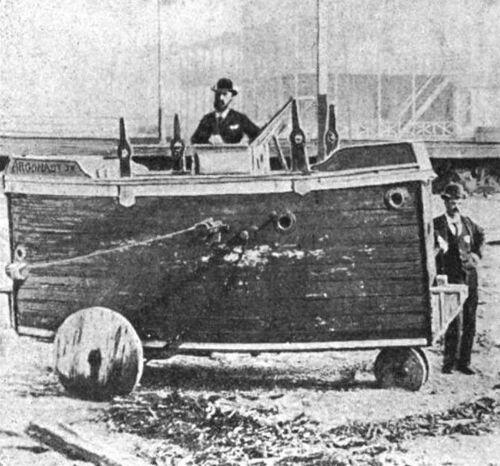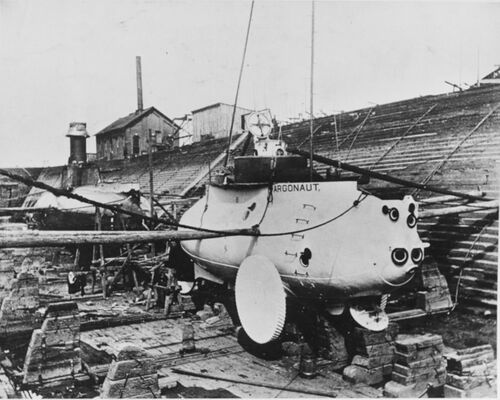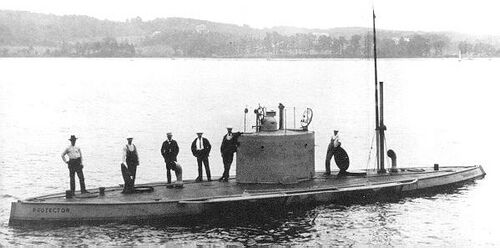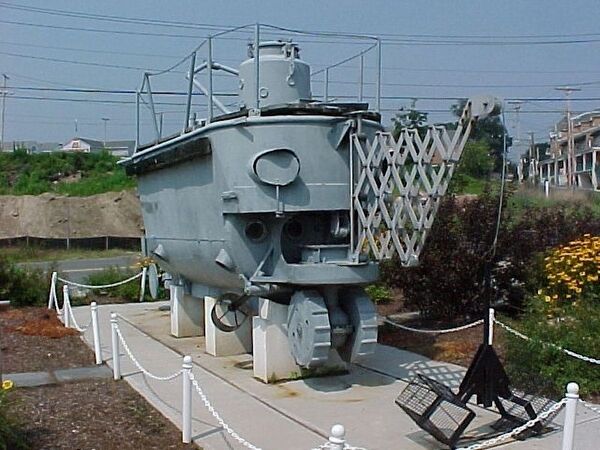Simon Lake non-Navy Submarines: Difference between revisions
Pbcjohnston (talk | contribs) →Simon Lake XV/Lake/Defender: Updated caption |
Pbcjohnston (talk | contribs) Added photos and captions |
||
| Line 2: | Line 2: | ||
=== <big>A brief history of Simon Lake</big> === | === <big>A brief history of Simon Lake</big> === | ||
<div style="text-align: justify;"><span style="color:#00008B">American inventor and engineer Simon Lake of New Jersey, later of Connecticut, was one of the great early pioneers in the development of submarines. He ranks right up there with John Holland, Narcis Monturiol, Thorsten Nordenfelt, Horace Hunley, and Gustave Zede in his influence on the development of the modern submarine. He was a brilliant engineer and visionary, who was inspired by the works of author Jules Verne. The fascination with Verne and his ''20,000 Leagues Under the Sea'' would drive his engineering philosophy for nearly the rest of his life. | <div style="text-align: justify;"><span style="color:#00008B">American inventor and engineer Simon Lake of New Jersey, later of Connecticut, was one of the great early pioneers in the development of submarines. He ranks right up there with John Holland, Narcis Monturiol, Thorsten Nordenfelt, Horace Hunley, and Gustave Zede in his influence on the development of the modern submarine. He was a brilliant engineer and visionary, who was inspired by the works of author Jules Verne. The fascination with Verne and his ''20,000 Leagues Under the Sea'' would drive his engineering philosophy for nearly the rest of his life. | ||
Lake began his life long pursuit of submarine technology in 1894, when he built his first boat, the wooden hulled, slab-sided Argonaut Junior. He followed this up four years later with the much more advanced metal hulled Argonaut 1. During this time he entered into an intense rivalry with his contemporary John P. Holland to design, build, and sell submarines to a newly interested United States Navy. | |||
Lake was highly influenced in his work by the Vernian ideals of submarine operations. He saw submarines chiefly in the exploration role, fulfilling a military function only as an aside. He saw his submarines as sailing on the surface to their operating area, diving to the bottom, then rolling along on wheels to a worksite. Suited divers would then emerge from a hatch in the bottom and perform the boat's mission. He was quite stubborn in this vision, and it drove much of his design work. Unfortunately, this vision was not shared by his primary customer, the United States Navy, who saw submarines primarily as a weapon, a mobile minefield upon which an attacking enemy force could be impaled on. | |||
To aid in his quest to sell submarines to the USN, Lake also developed the idea of submerging a submarine on a level plane, with a zero angle (sometimes called "even keel diving"). Holland used stern mounted diving planes and the power of the propeller to angle the boat downward and push it under, with surfacing being the opposite operation. Lake felt that this was too dangerous. If the crew lost control of the angle the boat could quickly exceed its hull strength depth and be destroyed. He emphasized the use of multiple sets of planes mounted amidships to ease the boat downward while maintaining a zero angle. | |||
Although a brilliant engineer, Lake possessed two qualities that tended earn him scorn and mistrust rather than the praise and lucrative USN contracts that he desired. He was quite stubborn in his beliefs about how submarines should be operated, and he refused to tolerate any challenge to those ideals. This stubbornness caused him to be quite outspoken when things did not go his way, earning him a reputation as a pariah. Secondly, despite his acknowledged talent as an engineer, Lake was a poor businessman and organizer. His shipyard was chronically underfunded and poorly managed, and thus his profit margin was quite low, and at times non-existent. Despite numerous attempts, Lake was unable to sell a submarine to the USN until 1912. He had been marginally more successful in the overseas market, but he struggled with the USN until this point. The acceptance of his [[G-1|'''submarine G-1''']] seemed to clear the log-jam for a bit, and over the next 10 years he sold a number of boats to the USN. However, the Navy never really liked his designs. They were mechanically and operationally complex, they had features that the Navy didn't like such as midships diving planes and watertight superstructures, and because of his poor management his boats were usually very late in delivery and lacking in construction quality. Finally tired of his business drama, the USN awarded Lake no more contracts after 1922 and his shipyard went out of business for good in 1924. | |||
This page will highlight some of the submarine work that Simon Lake did that ''was not'' accepted by the United States Navy. These boats, although never commissioned as warships in the USN, still were quite important in advancing the state of the art of submarine design and construction in the United States. The submarines that Lake built that were commissioned by the Navy will have their own pages under the Submarine Classes heading. | |||
[[File:Red bar sub new.jpg]] | [[File:Red bar sub new.jpg]] | ||
<div style="text-align: justify;"><span style="color:#000000"> | |||
===<big>Argonaut Junior</big> === | ===<big>Argonaut Junior</big> === | ||
</div> | |||
[[File:Lake Argonaut_Junior.jpg|left|500px]] | [[File:Lake Argonaut_Junior.jpg|left|500px]] | ||
| Line 26: | Line 34: | ||
[[File:Lake Argonaut 1.jpg|left|500px]] | [[File:Lake Argonaut 1.jpg|left|500px]] | ||
<div style="text-align: justify;"><span style="color:#00008B">Having secured investor funding, Lake built a follow-on vessel that He named Argonaut 1. Metal hulled and powered by a 30 hp gasoline engine, it was a tremendous advance over the Argonaut Jr. It also proved to be amazingly seaworthy, racking up over 2,000 miles of surface and submerged running, including an open-ocean transit from Cape May to Sandy Hook, NJ. It had wheels for rolling along the bottom and again a diver lockout chamber. From a military standpoint Lake marketed it as being able to stealthily enter a minefield, send a diver out, and cut mine cables. The same diver would also be able to gather intelligence on other underwater defenses and conduct salvage work. It had no other offensive capability. Pitched to the Navy, Lake failed to impress them with the boat's capabilities and the Navy did not buy it. Refusing to give up on the idea of rolling along the bottom, Simon Lake continued to build submarines with wheels up through 1909, when he built the [[G-1|'''G-1 (Submarine No. 19½)''']] for the Navy. The Navy however, was never impressed with the capability and refused to buy any more submarines with wheels. The concept died with G-1, only to be ironically revived by the nuclear-powered special operations submarine NR-1 in 1969. | <div style="text-align: justify;"><span style="color:#00008B">Having secured investor funding, Lake built a follow-on vessel that He named Argonaut 1. Metal hulled and powered by a 30 hp gasoline engine, it was a tremendous advance over the Argonaut Jr. It also proved to be amazingly seaworthy, racking up over 2,000 miles of surface and submerged running, including an open-ocean transit from Cape May to Sandy Hook, NJ. It had wheels for rolling along the bottom and again a diver lockout chamber. From a military standpoint Lake marketed it as being able to stealthily enter a minefield, send a diver out, and cut mine cables. The same diver would also be able to gather intelligence on other underwater defenses and conduct salvage work. It had no other offensive capability. Pitched to the Navy, Lake failed to impress them with the boat's capabilities and the Navy did not buy it. Refusing to give up on the idea of rolling along the bottom, Simon Lake continued to build submarines with wheels up through 1909, when he built the [[G-1|'''G-1 (Submarine No. 19½)''']] for the Navy. The Navy however, was never impressed with the capability and refused to buy any more submarines with wheels. The concept in the USN died with G-1, only to be ironically revived by the nuclear-powered special operations submarine NR-1 in 1969. | ||
This photo shows Argonaut 1 in drydock at the Columbian Iron Works facility at Locust Point, near Fort McHenry, in Baltimore, Maryland in approximately 1898. The large forward wheels and viewports at the bow are very apparent. Just below the forward viewports is the open diver's hatch. | This photo shows Argonaut 1 in drydock at the Columbian Iron Works facility at Locust Point, near Fort McHenry, in Baltimore, Maryland in approximately 1898. The large forward wheels and viewports at the bow are very apparent. Just below the forward viewports is the open diver's hatch. | ||
| Line 63: | Line 71: | ||
[[File:Red bar sub new.jpg]] | [[File:Red bar sub new.jpg]] | ||
<div style="text-align: justify;"><span style="color:#000000"> | |||
=== <big>Explorer</big> === | === <big>Explorer</big> === | ||
</div> | |||
<div style="text-align: justify;"><span style="color:#00008B"> | |||
<center> | |||
<gallery mode="packed" widths="400px" heights="300px"> | |||
File:Lake Explorer 1.jpg | |||
File:Lake Explorer 2.jpg | |||
</gallery> | |||
</center> | |||
<div style="text-align: justify;"><span style="color:#00008B">Although the Lake Torpedo Boat Company had closed its doors for good in 1924, Simon Lake continued to tinker with underwater technology projects for the remainder of his life. This boat is called Explorer and was a privately funded project by Lake built in 1936. It was strictly for exploration and salvage and was not a military craft. Going back to his roots Lake equipped it with wheels and a diver lockout chamber. It also had a mechanical arm to gather samples. It was very small and limited in its performance, and had its power and air supplied by a hose and cable connection to a mother ship on the surface. Not much is known about how this boat was used, and it eventually fell into obscurity after Lake's death in 1945. It was eventually rescued and restored, and is currently on display in Milford, CT. For more information on the Explorer, please see [https://cyberneticzoo.com/underwater-robotics/1931-3-explorer-submersible-simon-lake-american/ '''this link.''']</span> | |||
[[File:Red bar sub new.jpg]] | [[File:Red bar sub new.jpg]] | ||
Revision as of 13:18, 22 October 2023
A brief history of Simon Lake
Lake began his life long pursuit of submarine technology in 1894, when he built his first boat, the wooden hulled, slab-sided Argonaut Junior. He followed this up four years later with the much more advanced metal hulled Argonaut 1. During this time he entered into an intense rivalry with his contemporary John P. Holland to design, build, and sell submarines to a newly interested United States Navy.
Lake was highly influenced in his work by the Vernian ideals of submarine operations. He saw submarines chiefly in the exploration role, fulfilling a military function only as an aside. He saw his submarines as sailing on the surface to their operating area, diving to the bottom, then rolling along on wheels to a worksite. Suited divers would then emerge from a hatch in the bottom and perform the boat's mission. He was quite stubborn in this vision, and it drove much of his design work. Unfortunately, this vision was not shared by his primary customer, the United States Navy, who saw submarines primarily as a weapon, a mobile minefield upon which an attacking enemy force could be impaled on.
To aid in his quest to sell submarines to the USN, Lake also developed the idea of submerging a submarine on a level plane, with a zero angle (sometimes called "even keel diving"). Holland used stern mounted diving planes and the power of the propeller to angle the boat downward and push it under, with surfacing being the opposite operation. Lake felt that this was too dangerous. If the crew lost control of the angle the boat could quickly exceed its hull strength depth and be destroyed. He emphasized the use of multiple sets of planes mounted amidships to ease the boat downward while maintaining a zero angle.
Although a brilliant engineer, Lake possessed two qualities that tended earn him scorn and mistrust rather than the praise and lucrative USN contracts that he desired. He was quite stubborn in his beliefs about how submarines should be operated, and he refused to tolerate any challenge to those ideals. This stubbornness caused him to be quite outspoken when things did not go his way, earning him a reputation as a pariah. Secondly, despite his acknowledged talent as an engineer, Lake was a poor businessman and organizer. His shipyard was chronically underfunded and poorly managed, and thus his profit margin was quite low, and at times non-existent. Despite numerous attempts, Lake was unable to sell a submarine to the USN until 1912. He had been marginally more successful in the overseas market, but he struggled with the USN until this point. The acceptance of his submarine G-1 seemed to clear the log-jam for a bit, and over the next 10 years he sold a number of boats to the USN. However, the Navy never really liked his designs. They were mechanically and operationally complex, they had features that the Navy didn't like such as midships diving planes and watertight superstructures, and because of his poor management his boats were usually very late in delivery and lacking in construction quality. Finally tired of his business drama, the USN awarded Lake no more contracts after 1922 and his shipyard went out of business for good in 1924.
This page will highlight some of the submarine work that Simon Lake did that was not accepted by the United States Navy. These boats, although never commissioned as warships in the USN, still were quite important in advancing the state of the art of submarine design and construction in the United States. The submarines that Lake built that were commissioned by the Navy will have their own pages under the Submarine Classes heading.
Argonaut Junior

Photo courtesy of Wikipedia.org
Argonaut 1

This photo shows Argonaut 1 in drydock at the Columbian Iron Works facility at Locust Point, near Fort McHenry, in Baltimore, Maryland in approximately 1898. The large forward wheels and viewports at the bow are very apparent. Just below the forward viewports is the open diver's hatch.
It is interesting to note that there is another submarine in the dock with the Argonaut. Behind her is the Holland submarine Plunger of 1895, also known as the Holland V. It was an experimental submarine built by Holland under a Navy contract. Steam boiler powered, it was a complete failure and it was never accepted by the Navy or commissioned into service. Never completely finished it lingered at the Holland facility at New Suffolk, NY until it was scrapped in 1917.
Photo NH 57030 courtesy of NHHC.
Protector

This photo was most likely taken shortly after her completion in late 1902. The location is near his company yard in Bridgeport, CT. Note guards at side of vessel to protect the diving planes from damage.
Simon Lake XV/Lake/Defender
This photo shows the Lake moored during the 1906 competition with the Octopus. Her broad, flat deck is quite apparent. Note the unusual oblong torpedo loading hatch and the guard rails protecting the amidships diving planes. She had a helm atop the conning tower and a type of a periscope that Simon Lake called an "omniscope".
This is a very rare photo that is exclusive to PigBoats.COM. Originally it was a postcard that was acquired by Ric Hedman. It had black postal marks on it that partially obscured the image. After being scanned electronically it was painstakingly restored by PigBoats associate Matthew Tripp. The result is an unique look into American submarine history.
Explorer
Page created by:
Ric Hedman & David Johnston
1999 - 2023 - PigBoats.COM©
Mountlake Terrace, WA, Norfolk, VA
webmaster at pigboats dot com


